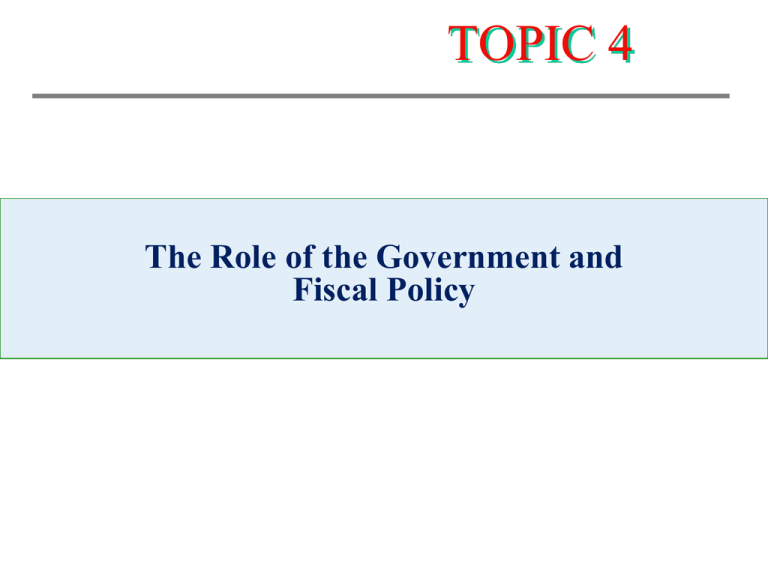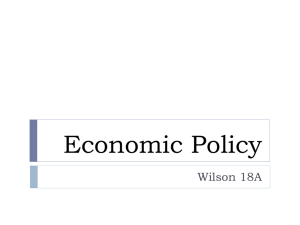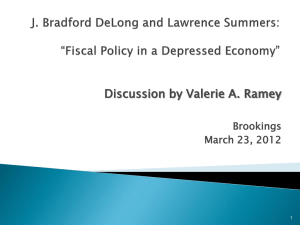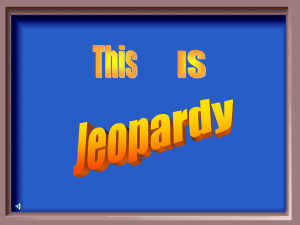Power Point
advertisement

TOPIC 4
The Role of the Government and
Fiscal Policy
The I-S Curve and Fiscal Policy
Fourth Major Curve of the Course: IS curve
•
IS curve represents demand side of the economy drawn in {Y,r} space:
Y = C + I + G + NX
or (given definitions of disposable income and saving from lecture 1)
S(hh) + S(govt) = I + NX, or
S = I + NX
The IS curve is so named because it documents the relationship between Saving and
Investment (holding NX constant).
3
Fourth Major Curve of the Course: IS curve
•
C
is a function of PVLR (Y, Yf, W), tax policy, expectations (i.e., consumer
confidence), liquidity constraints
•
I
is a function of r, A, business confidence, liquidity constraints, and investment tax
policy.
•
G
is a function of government policy (we will discuss this shortly)
•
NX
we will model in the last lecture of the course (for the U.S., NX is small)
•
The IS curve relates Y to r. How do interest rates affect Y?
– As r falls, Investment increases (due to MPK and firm profit maximization behavior).
– IS curve is downward sloping in {r, Y} space.
•
For next week or two we will IGNORE the supply side of the economy (just to build
intuition) --- after that, we will put demand and supply together.
4
Demand Side Analysis (IS Curve)
r
r*
r*
IS
Y*
Y
Suppose r is set by the Fed at the level of r* (we will explore this in depth later in the course).
For a given r, we can solve for the level of output desired by the demand side of the economy.
We represent the demand side of the economy, drawn in {r,Y} space as the I-S curve. Why IS?
Because the demand side of the economy can be boiled down to I = S (when NX is zero)
5
Note: Y need not equal Y* - I drew it this way for illustrative purposes.
Some Thoughts on IS Curve
What shifts the IS curve?
Anything that causes C, I or G to change (or NX when we model it).
What shifts IS curve to the right? (i.e., makes Y higher on the demand side of the economy)
Increase in consumer confidence (expectations of future PVLR)
Permanent increase in stock market wealth.
A permanent reduction in income taxes (if households are PIH or Keynesean)
A temporary reduction in income taxes (if households are Keynesean or Liquidity
Constrained PIH).
An expected future increase in TFP (stimulates investment demand).
An increase in government spending (i.e., war).
•
Changes in r WILL NOT cause IS curve to shift (causes movement along IS curve).
•
You should be able to answer:
Why does the IS curve slope down?
6
Suppose Consumer Confidence Falls
Suppose consumer confidence falls (and no effect on Y*). IS curve will shift in.
r
C falls
r*
r*
IS1
Y1
IS
Y*
Y
Assume that investment, NX, and G do not change!
7
Fiscal Policy
• Fiscal policy is the use of government spending (G) and taxes (tn) to
stabilize the economy.
•
Governments can have:
– Output targets
– Price targets
– Unemployment targets
•
Stabilizing the economy means moving the economy towards its targets. We will ignore
price targets for now (we have no prices in our model yet).
•
Suppose the government has an output target and suppose that target is Y* (we will also
explain why Y* is a good target later in the course).
•
Fiscal policy then would be the manipulation of G and tn to move the economy towards
Y*. (Assumes government knows where Y* is - we will discuss other drawbacks to
fiscal policy later in the course).
8
Example of Fiscal Policy: Consumer Confidence Falls
Government can undo the decline in consumer confidence by increasing G or decreasing
tn - this is fiscal policy
r
C falls
r*
r*
G increases
IS1
Y1
Y*
IS = IS2
Y
Compute Change in G: If ΔG = -Δ consumer confidence,
Y will remain unchanged (taking r as fixed)
9
A Look at U.S. Debt and Deficits
U.S. FEDERAL DEFICIT (RELATIVE TO GDP)
U.S. FEDERAL DEFICIT (RELATIVE TO GDP)
SINCE 2009
U.S. FEDERAL DEBT (RELATIVE TO GDP)
SINCE 1990
U.S. PUBLIC INTEREST PAID
(RELATIVE TO GDP)
The Cyclicality of Government Budget Deficits
Some Additional Structure on Taxes and Transfers
Let us start with some definitions about debts and deficits.
Tax Revenues
= tnY
Transfers Payments = Tr – g Y
(where tn is the marginal tax rate on income)
(where g is the relationship between transfers
and income)
Rationale for specifications:
1.
When Y increases, taxes revenues increase (more earnings in economy).
-
2.
This is built into the tax code.
You are taxed based upon what you earn.
When Y increases, transfers payments fall (less people on welfare)
-
This is built into our social programs.
We transfer more money to people when their income is low.
16
Some Deficit Terminology
Actual Government Deficits
= Outlays (G and Tr) – Revenues (T)
= G + Tr – g Y - tnY = G + Tr – (g + tn)Y
Note:
For now, ignore other government revenues and expenses (like interest on
government debt). See text for further discussion if interested.
Definition:
Structural Budget Deficit is the deficit that would exist if the
economy were at Y*:
Structural Budget Deficit = G + Tr – (tn + g)Y*
Note:
Difference between structural deficits and actual deficits is only due to
differences between Y and Y*.
Cyclical Budget Deficits = Actual Budget Deficits - Structural Budget Deficits.
Cyclical deficits occur anytime Y does not equal Y*!
17
The Nature of Deficits
• Deficits are countercyclical! (They rise when Y falls and fall when Y rises)
• Even if the government has a policy (combination of G and T) that would lead
to no deficits at Y* (the target level of output for the economy), deficits could
still occur.
The reason: Y does not always equal Y*.
• Why do we get countercyclical deficits?
Welfare Payments, Unemployment Insurance, and Tax System dampen the
effects of consumption over the business cycle.
– T goes up when times are good (like in the late 1990s).
– G/Tr goes up when times are bad (welfare payments).
– We refer to such policies that dampen consumption as “automatic stabilizers”
• Given “automatic stabilizers” (and potentially proactive governmental fiscal
policies), cyclical deficits seem to be an inherent part of our economy.
18
Should Governments Try To Prevent Deficits?
•
Examples: U.S. Balanced Budget Amendment. Maastricht criteria for entry to
European Economic and Monetary Union (EMU) that deficit/GDP be 3% or less and
that debt/GDP be 60% or less.
•
Benefits: Limit Spending: If spend today, government must;
1) Raise Taxes Now
2) Raise Taxes in Future
3) Print Money In Future
•
(changing taxes frequently creates economic uncertainty)
(higher taxes cause disproportionately more distortions )
(could lead to inflation)
Is there a cost? Yes - balanced budget amendments can make economic situations
worse. Refer back to the example earlier in this lecture when consumer confidence fell.
As Y fell, tax revenues fell. As tax revenues fell, deficits (cyclical) increased. If the
government had to balance the budget, they would either have to cut G or increase T both of which would cause the IS curve to shift further to the left.
•
Conclusion - it may be bad to have policies requiring governments to eliminate all
deficits, but there may be some benefits from eliminating structural deficits.
19
Government Spending at Y* (model preview)
Increase in G at Y*: Investment Adjusts
LRAS = Y =Y*=f(A,K,N*)
r1
r*
IS = Y=C+I+G
Y*
Y
Suppose we start at Y* such that Y is pinned down by the supply side
(i.e., labor markets clear, all resources used efficiently)
21
Increase in G at Y*: Investment Adjusts
LRAS = Y =Y*=f(A,K,N*)
r1
I
r*
G
IS1 = C+I1 +G1
IS = Y=C+I+G
Y*
Y
Assumption:
Increase in G has no effect on A!
Model:
Increase in G has no effect on N* (no effect on labor supply or
labor demand).
22
What is the Effect of Running a Deficit at Y*?
Situation 1:
Equation 1:
Crowding Out of Investment:
Y=C+I+G
Equation 2: SHH + Sgvt = I (if NX = 0)
If Y is pinned down by supply side of economy (such that ΔY = 0 if G increases), then
either C or I must fall to offset increase in G (i.e., ΔG = - ΔI).
Why would I fall? Increase in interest rates (we will prove once we build a model of
money market).
What is the effect of falling I (due to increased G) on future generations? Lower I today,
means lower K tomorrow. Lower K tomorrow means lower Y* tomorrow (lower
economic growth).
If at Y*, increase in deficit will hurt future generations unless the deficit has a non-trivial
effect on A (given Cobb Douglas Production: If %ΔA > 0.3 * %Δ K, then deficit
could help future generations.)
23
What is the Effect of Running a Deficit at Y*?
Situation 2:
Ricardian Equivalence:
Adjustment occurs on C as opposed to I (to keep Y at Y*)
Definition:
Ricardian Equivalence: Theory that states that consumers’ behavior is
equivalent regardless if the government finances G (government
expenditures) through increased taxes or through increased debt
Key:
If the government floats debt to finance the spending today, consumers
realize that the government, at some time in the future, will have to raise
taxes to pay back the debt.
Summary:
A reduction in taxes today (an increase in G today) will be seen as being
accompanied by higher taxes in the future. Households will save today
to fund the future tax increases (they expect disposable income in the
future to fall). National Saving would remain unchanged.
In terms of equations:
Y is fixed, C falls and Shh goes up (prevents crowding out of
investment ; I can stay fixed)
24
Does Ricardian Equivalence Hold?
For the most part, there is little evidence to support the existence of Ricardian Equivalence.
Why?
Myopia
Liquidity Constraints
High Levels of Impatience.
Do not care about bequests/future generations
Timing of Taxes is Important (taxes are not lump sum).
It does not mean that it will never hold (some people point to Japan in the mid 1990s).
For the rest of the course, we will assume consumers are “non Ricardian” unless told
otherwise. This means that consumers will not adjust their consumption downward
today in expectation of an increase in taxes tomorrow.
Ricardian consumers, however, would adjust their consumption downward today in
expectation of increases in taxes tomorrow (because PVLR falls).
25
Government Spending During Recessions
What’s the difference between increasing government spending (G)
in recession vs. at Y*? A Simplified Framework
Forces at Y* (a summary)
o
o
o
o
Crowd’s out investment (lower K) <<cost 1>>
Potentially increase productivity (higher A) <<benefit 1>>
Dead weight loss of raising future taxes (distortions are lower with a
constant tax rate than a variable tax rate with same mean). <<cost 2>>
Governments are inefficient <<cost 3>>
Additional Forces in Recession
o
Slack resources in economy. An increase in spending could generate new
spending if resources are slack. This is a key component of government
spending multiplier . << benefit 2 >>
- Depends on the extent to which government spending mobilizes slack
resources.
- Need to account for the fact that slack resources have some value.
27
Government Spending Multiplier: A Simplified Framework
• Tries to measure the net change in GDP today from a given change in
government spending today.
o
Measured by ∂Y/ ∂G
o
Components of multiplier:
- Benefit 2 (slack resources may be mobilized), let’s think of this as a
private sector spending multiplier.
- Cost 1 (investment may be crowded out) [Would be similar if
consumption is crowded out if consumers are Ricardian]
o
Ignores potential future costs
- Benefit 1 (potential benefits on future productivity).
- Costs 1, 2 and 3 (lower capital stock in future ; more dead weight
loss from future tax increases ; governments are inefficient relative to the
private sector).
o
Ignores value of resources when slack
28
A Simple Model of a Government Spending Multiplier
• Focus on demand side only (no link to supply side)
• Assume interest rates do not adjust to change in government spending
o A crazy assumption (we will model interest rates next week).
o Not so crazy when interest rates are “stuck” at zero (what economists call
the Zero Lower Bound).
o Ignoring interest rate changes assumes away the crowding out of investment.
• Assume consumers do not adjust spending to changes in government
spending.
o Implies consumers are not Ricardian.
• This simple model (with the stark assumptions) underlies the intuition for
29
the old Keynesian government spending “multiplier”.
Why is There a Potential “multiplier” When Y < Y*?
Suppose we have the following model:
C = a + b(Y – T)
<< assume some fraction of consumers are liquidity
constrained so they act Keynesian>>
I = I0 – I1 r
<<Investment is negatively related to interest
rates>>
T = tn Y
<<Marginal tax rate on labor income>>
Other assumptions:
Transfers = 0 ; G = G0 ;
Y << Y* ;
closed economy (NX = 0 always)
What is the equilibrium level of Y?
Y = C + I + G = a + b(Y – tnY) + I0 – I1 r + G0
Solve for Y (Use algebra – one equation, one unknown)
Y = [a + I0 – I1 r + G0] / [1-b(1-tn)]
30
What is the private sector multiplier in the Simple Model?
Given the Simple Economy on Previous Page:
Y = [a + I0 – I1 r + G0] / [1-b(1-tn)]
What is the multiplier of a change in government spending (G) on Y?
dY/dG = 1/[1-b(1-tn)]
What is b?
Some estimates range from 0.3-0.4 in recession.
Where are the estimates from? -- Micro data analyzing tax rebates (a
change in taxes not a change in government spending).
What is t?
Marginal tax rate – roughly 0.25-0.35
What is the government spending multiplier in this simple model?
dY/dG is approximately 1.3 (if b = 0.35, t=0.3)
31
The Simple Keynesian Multiplier
• Upper bound on the true (or net) government spending effect on output.
o
Ignores the crowding out of investment by holding interest rates fixed.
o
Ignores consumer responses by imposing Ricardian equivalence.
o
Ignores any supply side effects (prices may adjust – more on that when we
build a model of prices).
• Government spending multipliers will be higher in recessions
o
More slack resources can be mobilized without “crowding out”
investment.
32
Estimated Multipliers in Policy Discussion
Christy Romer (Former Chair of the President’s Council of Economic Advisors)
-
Estimates the net government spending multiplier to be around 1.6
Does so by using time series analysis of large government spending changes (like
wars)
I do not believe the time series analysis (too much other stuff going on – standard
errors are huge)
See:
http://alaskakid.wordpress.com/2009/02/28/christy-romer-02-27-09-fiscal-stimuluslikely-effects-of-the-arra/
Robert Barro (Harvard Professor – Potential Soon to be Nobel Prize Winner)
-
Estimates the net government spending multiplier to be around 0.8
Also uses time series analysis (roughly same data as Romer – different empirical
approach)
I still do not believe the time series analysis
http://online.wsj.com/article/SB123258618204604599.html
33
My Thoughts
1.
Multipliers are likely much higher in recessionary times than in nonrecessionary times.
2.
All else is not equal: The government spending is not efficient.
o
o
o
3.
Some of the spending – however – may actually increase future TFP (a
multiplier on Y* instead of Y).
o
•
With the past big stimulus program, I think the inefficiency was likely
even higher than in the past. Have you ever tried to spend $400 billion
quickly AND efficiently? There is no chance that this was successful.
My sense is the inefficiently could be large. A lot of the government spending
will be wasted.
Hard to maximize slack resources and be efficient. Do we need more roads in
Detroit?
With the current stimulus, some spending may increase future TFP. I am not sure
how big this will be.
My best guess on the total multiplier (the net effect of the relative
inefficiency of government, the private sector spending multipier, and the
potential effect of government spending on TFP) was probably close to
zero or negative.
34
Definition: Supply Side Economics
Supply Side Economics
Any fiscal policy designed to stimulate the supply side of the economy (A, K and
N)
Examples:
1)
Changing marginal tax rates (stimulate N)
As discussed before , these policies may not have big effects (off setting
income effects and substitutions effects ; empirically small estimates of
labor supply response).
2)
Subsidizing A and K (investment tax credits, research and
development subsidies, subsidizing education, etc.)
These programs have been shown as being effective ways to promote
economic growth within an economy.
36
A Discussion of Inequality
Inequality Mania
• Recent empirical work showing inequality is increasing:
o
Income inequality (Kevin Murphy, Larry Katz, Emmanuel Saez, Thomas
Piketty, Ed Glaeser).
o
Consumption Inequality (Steve Davis , Me)
o
Employment Inequality (Kevin Murphy, Bob Topel, Me)
o
Wealth Inequality (Thomas Piketty, Emmanuel Saez)
• What are the causes of increased inequality?
• Is increased inequality detrimental to a society?
38
Thomas Piketty Capital in the Twenty First Century
• Book: “Capital in the Twenty First Century” - Worldwide best seller.
• Documents wealth inequality increases around the developed world.
• Claim: economic conditions are such that eventually most wealth will be
concentrated in the hands of the rich.
o
o
Forces will continue to make inequality grow.
Reason: rate of return on capital > income growth (i.e., r > g)
• Policy prescription: Tax wealth
• What we will do: Walk through the Piketty argument and discuss necessary
assumptions (and plausibility of assumptions). Draw on discussion by Justin
Wolfers (http://users.nber.org/~jwolfers/papers/Comments/Piketty.pdf)
39
U.S. Income Inequality: Top 10% “Kuznet’s Curve”
40
Cross-Country Income Inequality: Top 1%
41
U.S. Wealth Inequality
42
Some Key Ingredients for the Piketty Story to hold
• An identity: Define α as the capital share of total income. By definition, that
is:
rt * Kt
t
Yt
• This is not controversial – it is just a definition that all economists believe.
• Note: Under a Cobb-Douglas production function, α is fixed (some number like
0.3).
o
See supplemental notes #3 for a discussion.
43
Some Key Ingredients (in bold) for the Piketty Story to hold
• Start with our identity and assume interest rates are constant over time:
rK t
t
Yt
• Assume there is no depreciation of the capital stock such that:
t
r( Kt 1 I t )
Yt
• Remember that in equilibrium St = It. Further, assume that national saving
(St) is a constant fraction s of national income (Yt) so that:
t
r ( Kt 1 sYt )
Yt
44
Some Key Ingredients in the Piketty Story
• We now have a recursive equation:
t
r ( K t 1 sYt )
Yt
r ( K t 2 sYt 1 sYt )
Yt
r ( K t 2 s(1 g )Yt sYt )
Yt
Here, a constant growth
rate of income (g) is
assumed. This allows us to
keep all output in terms of
today’s output, Yt.
r ( K t 3 s(1 g ) 2 Yt s(1 g )Yt sYt )
Yt
rsYt (1 g )t
t 0
Yt
s
r
g
45
Summary
rt Kt
s
t
r
Yt
g
• The share of going to capital income will continue to increase if r > g.
• Will increase inequality if wealth is concentrated.
• Piketty argues that r > g.
• Cannot happen under a Cobb-Douglas production function.
46
Problems with Piketty Story: Theoretical
• Interest rates are exogenous
o
As capital stock grows, all economic theory says that MPK will fall. As
MPK falls, real interest rates will fall.
o
How fast real interest rates falls depends on elasticity of substitution
between capital and labor of firms. (i.e., Cobb Douglas has a constant
elasticity such that the capital share of income is always constant).
o
Bottom line – interest rates will respond.
• Depreciation is missing
o
As capital stock increases, more investment is needed to replace outdated
capital. True formula with depreciation:
rt Kt
s
t
r
Yt
(g )
47
Problems with Piketty Story: Theoretical
• Consumption is not PIH in his model
o
Assumes that returns to capital are always reinvested (not consumed).
o
If consumption goes up, saving rates are not constant over time.
o
Do the really rich keep a constant saving rate?
o
How do we think about giving to charity?
o
Returns to housing are mostly consumed.
o
Much of the increase in wealth inequality in last 30 years was driven by
increased housing wealth of the top wealth households.
• Summary: Models that allow for optimizing consumers, profit maximizing
firms, and depreciation have trouble coming to the conclusion that wealth
inequality will grow unbounded.
48
Some Other Issues
• Most of the increased inequality within the U.S. NOT due to changes in capital
income. The rich are getting richer because of labor income.
• How do we think about labor income vs. capital income for the really rich?
• High salary growth in finance, skilled professionals, CEOs, etc. Has nothing to
do with the increase in capital income.
• Do we only care about the top 1% (or 10%) relative to the median? What
about the gap between the 75th percentile and the 25th percentile? That has
grown dramatically as well (college vs. non-college premium).
• What is the optimal policy response if we care about inequality? Taxing the
rich? Helping to educate the poor? Allowing high skilled immigration?
49
Outside Piketty: Some Final Thoughts
• Are there benefits to income inequality?
– In human capital models, unequal returns to skill are necessary to induce
people to invest in human capital.
– “The widening inequality in earnings and the buoyant demand for skilled
workers also indirectly encourages greater growth in the economy by
increasing the incentives for young people to invest in themselves.” Gary
Becker, The Economics of Life
50
Outside Piketty: Some Final Thoughts
• Is income inequality detrimental to society?
– The economic literature has focused on documenting trends in inequality and
modeling the determinants of income inequality.
– However, the consequences of inequality are relatively understudied due to
some challenges in research design.
– How do we think about:
o The health of societies that are unequal?
o Intergenerational mobility?
o Income segregation (do poor and rich people choose to live next to each
other)?
o Political participation (who votes? who gives money to candidates?)?
51








